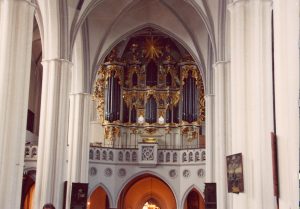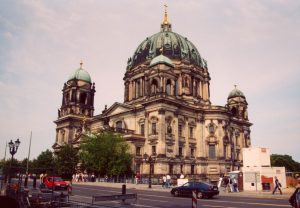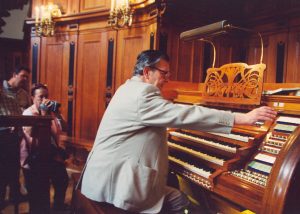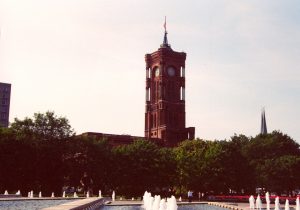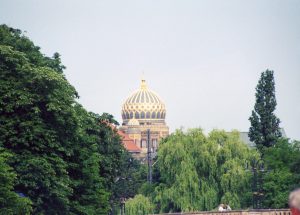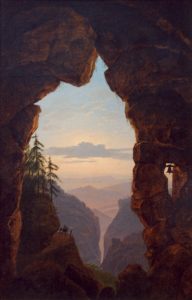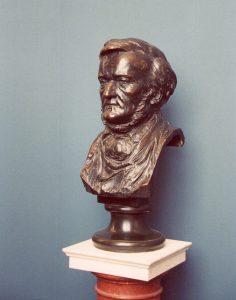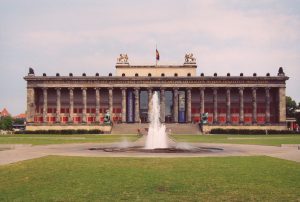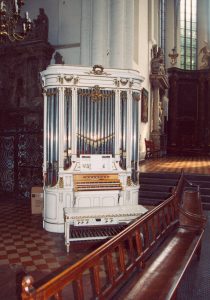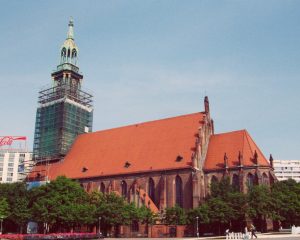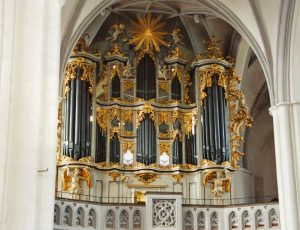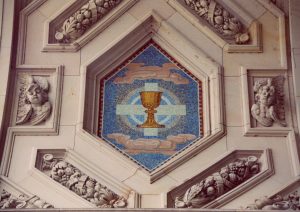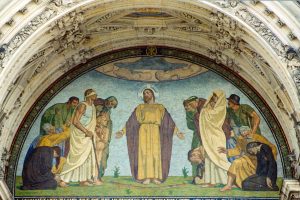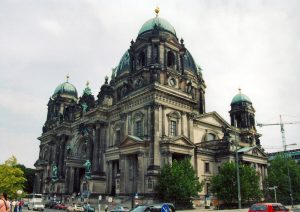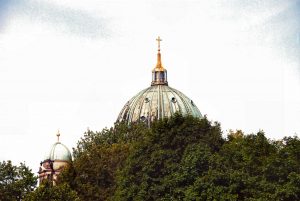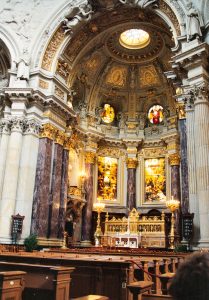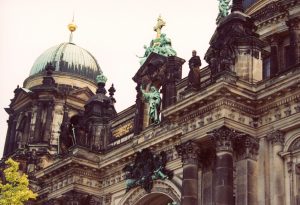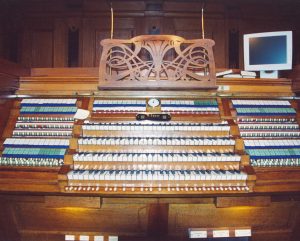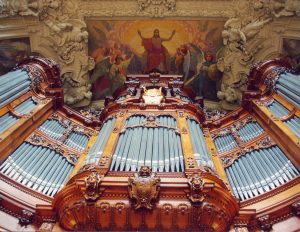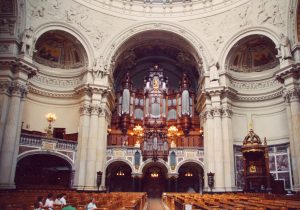Historic Organs of Germany
Berlin
June 14, 2003
Saturday morning began slowly, with a leisurely breakfast in the hotel dining room. Even there, we had a chance to see another organ, as you can see from the photograph to the right. I opened it up and saw the barrel with pins, and what appered to be two ranks of pipes, but prudence won out, so I didn’t turn the handle to hear what the tune would be.
Our hotel couldn’t have been better situated, and as we walked to our appointment with the Sauer Organ in the Berlinerdom, we had the chance to pose for a few pictures in the Alexanderplatz, to indulge in a little horseplay around the Neptunbrunnen, and to get a general feel for this amazing city. Of course, when we saw the doors of the Marienkirche open, we took the opportunity to walk inside and at least look at the recently restored Joachim Wagner case of 1722. The case houses a new organ by Daniel Kern, but we didn’t have the chance to hear it this trip. Even the small Chororgel was intriguing.
Perhaps the next time?
After enjoying our time as tourists, we finally arrived at our goal. We were early enough to have time to walk around and look at the impressive structure itself before our appointment. After the damage done during WWII, rebuilding had not begun for some thirty years, and repairs to the stonework were quite visible all around the perimeter. Again, a sobering reminder of the past.
Once we were ushered to the organ loft, Domorganist Michael Pohl gave us a wonderful demonstration of this enormous instrument, finished by Wilhelm Sauer in 1905, when the Dom itself was built. His explanation of the mechanism and demonstration of many individual stops was revealing, even though we didn’t have time to hear all 53 8′ stops individually. He was open to questions, and played different sounds for us to compare, demonstrated the crescendo available through use of the Walze, and ended with a performance of a movement from a Rheinberger sonata. Compared to the instruments we had heard in the past three days, this was another world entirely! Watching his performance gave us some idea of the console technique required to perform this music—or that of Reger or Karg-Elert—on an instrument contemporary with their music.
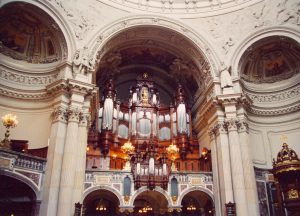 More importantly, this was our first chance to hear the dynamic contrasts available within the 8′ pitch level on instruments of this type. The way all 8′ registers of a single division built on each other was unlike any other organ I’ve heard or played, and the use of couplers allowed an absolutely seamless crescendo using the Rollschweller. After Herr Pohl played, I had the chance to play two chorale preludes from Reger’s Opus 67. Using the console devices, including the Swell shoes, was a bit awkward at first, but the biggest challenge I found was the pneumatic key action. The demonstration made it clear that there was a noticeable delay when playing stops of Manual IV, and I could adjust to that fairly easily. It wasn’t unlike playing the 1919 Austin I played as an undergraduate, an instrument whose console had been moved around the corner and into another room! It was more difficult, though, to adjust to feeling and hearing the pallets within the console open as I played. I found that the slightly different response was not so much a problem, but that I had to adapt my technique in a way that was significantly different from the way I played either tracker or electro-pneumatic instruments. This is an experience I would like to have over a period of a few weeks or months, just so I could better understand the connection between these instruments and their literature.
More importantly, this was our first chance to hear the dynamic contrasts available within the 8′ pitch level on instruments of this type. The way all 8′ registers of a single division built on each other was unlike any other organ I’ve heard or played, and the use of couplers allowed an absolutely seamless crescendo using the Rollschweller. After Herr Pohl played, I had the chance to play two chorale preludes from Reger’s Opus 67. Using the console devices, including the Swell shoes, was a bit awkward at first, but the biggest challenge I found was the pneumatic key action. The demonstration made it clear that there was a noticeable delay when playing stops of Manual IV, and I could adjust to that fairly easily. It wasn’t unlike playing the 1919 Austin I played as an undergraduate, an instrument whose console had been moved around the corner and into another room! It was more difficult, though, to adjust to feeling and hearing the pallets within the console open as I played. I found that the slightly different response was not so much a problem, but that I had to adapt my technique in a way that was significantly different from the way I played either tracker or electro-pneumatic instruments. This is an experience I would like to have over a period of a few weeks or months, just so I could better understand the connection between these instruments and their literature.
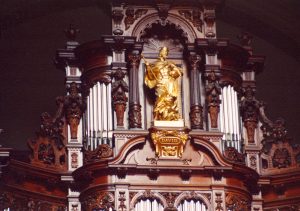 We had to leave the loft at noon, and that gave us the chance to hear the organ from below during the service that followed. The opportunity to hear the organ used for this purpose was again a valuable experience for all of us, as was the opportunity to hear both improvisations and literature used in the service. Afterwards, Herr Pohl graciously allowed the rest of the organists in our group to play the organ, and the rest of us remained below and listened to Reger, Karg-Elert, and Bach.
We had to leave the loft at noon, and that gave us the chance to hear the organ from below during the service that followed. The opportunity to hear the organ used for this purpose was again a valuable experience for all of us, as was the opportunity to hear both improvisations and literature used in the service. Afterwards, Herr Pohl graciously allowed the rest of the organists in our group to play the organ, and the rest of us remained below and listened to Reger, Karg-Elert, and Bach.
Following this, we had the rest of the afternoon to spend as tourists, and different ones of us went to different museums, enjoyed lunch of Wurst mit Brötchen, and walked through more of this city. Eventually we had to leave though, and board the bus for an early evening ride to Dresden.
Journal Entry
June 14 The afternoon spent in Berlin was very exciting. I ended up walking along the main thoroughfare, “Unter den Linden Strasse” to see such sights as the imposing statue of Frederich the Great on horseback, the German History Museum, Berlin Operahouse, and close to the Dom, the Antiquities Museum. I walked through a small street fair, where local artisans were selling their wares, and purchased two very beautiful, hand-painted goose eggs, a traditionally German art. I had so hoped to see the famous Pergamon museum, housing the ancient Greek Pergamon altar. However, I was sorely dissapointed to find the Pergamon Museum closed and under repair! The Antiquities museum was interesting, although I confess ancient Mycenian and Cretian art has never appealed to me on a grand scale. The late Roman wood paintings made the trip through the Antiquities Museum worth my while—it was amazing that these slips of hand-painted wood had survived almost 2,000 years, and the faces painted on them just as visible as they were 2,000 years ago.
Photos
The photographs of the interior of the Berlinerdom in the text above and in the photographs below were made by KC Hayes.


